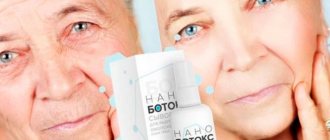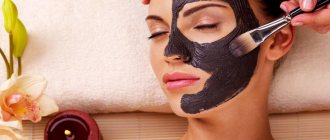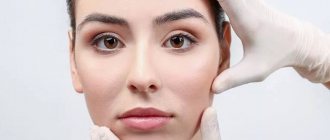Category: Injection cosmetology Published 01/05/2019 · Comments: · Reading time: 8 min · Views: 58,300
Botox facial procedure is a procedure to eliminate wrinkles and hyperhidrosis (excessive sweating). The drug contains botulinum toxin, which leads to blocking of muscles and sebaceous glands. When administering this drug, there are indications and contraindications, and particularities of administration.
Composition of drugs
Both drugs contain water-soluble protein Albumin (Albuminum humanum) and sodium chloride.
Difference between Botox and Botulax:
- production technology;
- cleaning level;
- auxiliary components;
- dosage;
- price.
Let's look at each tool in more detail.
…
Botox
A classic anti-aging product with botulinum toxin, it has long been successfully used in cosmetology and medicine. Produced by the American company Allergan. World famous, well studied. The effect lasts up to 6-8 months.
Compound:
- purified class A botulinum toxin to suppress muscle impulses and relax muscles;
- Albumin is a protein for tissue repair;
- sodium chloride is a solvent for the ingredients of the drug.
Storage method: at temperatures from -3o to -17o.
…
Botulax
Manufactured by the South Korean company Hugel Inc. The effect lasts up to 4-6 months.
A relaxing antipsychotic with a good effect on facial muscles. The basis of the composition is highly concentrated protein botulinum toxin A. For stabilization, auxiliary ingredients are present. Injections are carried out slowly - foaming may occur if injected quickly.
Compound:
- Category A protein neurotoxin;
- simple water-soluble proteins in whey;
- sodium chloride 0.9%.
The prepared solution is stored for no more than a day at temperatures up to +7o.
Botox for hair Honma Tokyo: composition
Manufacturer Honma Tokyo promises that their H-BRUSH Botox Capilar acts at the cellular level, filling the hair structure and restoring it. The advertised composition of Honma Tokyo Botox is N-Acetyl cysteine, Luna Matrix system (Silver Matrix), elastin, green tea extract, prakaxi oil.
But let's not blindly trust promises. Let's look at the label. And we are horrified. The next few positions after water are occupied by cheap surfactants, the same surfactants that are used in mass-market cosmetics. This:
- Cocamidopropyl betaine.
Among other things, it has a conditioning effect: it facilitates combing and prevents electrification. As with any chemical, local allergic reactions are possible. - Cocamide DEA.
Used to improve the appearance of the product and give it thickness. Has a softening and antistatic effect on hair. A number of scientists talk about its carcinogenicity, the ability to cause cancer. The fact that this is an unsafe component is evidenced by the fact that there is a standard for permissible concentrations of this substance in cosmetics. There is information that side effects may include dry hair, itching, and dandruff. - Triethanolamine.
Preservative and solvent. May cause dry skin, peeling, irritation, itching, burns. The permissible level of content in substances of prolonged contact with skin is 5%.Next comes the also popular chemistry:
- Phenoxyethanol.
Known as a repellent, that is, a means to repel insects. In cosmetics it is used as a preservative. A regular on top cosmetic ingredients that are irritants. The permissible concentration in cosmetics is 1%. Prohibited in organic cosmetics by all European certificates. - Guar Hydroxypropyltrimonium Chloride.
The detangling conditioner thickens and moisturizes hair. For some, it leaves a feeling of unwashed hair - “icicles”. - Sodium chloride.
Everyone knows it as table salt. In cosmetics it is used as a thickener. May lead to dryness, irritation and hair loss. Neutralizes the effect of keratin. Will you voluntarily rub salt into your skin and hair?
The list of cheap chemicals in Honma Tokyo Botox is completed by several more synthetic preservatives, fragrances, stabilizers, and alcohols. And only the last two components - 2 out of 18 (!) - have something in common with the useful composition that the manufacturer promises. This is green tea extract and prakaxi tree oil. All! Considering that they are at the very tail of the lineup, their number is miniscule.
Conclusion: the entire effect of Honma Tokyo Botox is based on the most ordinary chemistry used in economy segment products. This is how unique compositions with intriguing names are created! Matrix of silver! And now the fanfare: 250 ml of this “Botox” costs 2.5-3 thousand rubles.
Indications for use
Korean and American drugs are used in cosmetology for people aged 20 to 65 years, the target audience is 30-45 years. The effect lasts until the botulinum toxin is completely removed from the body, after which the procedure is repeated.
The drugs showed especially good results when correcting facial asymmetry, modeling oval shapes, and eyebrow lines.
For deep wrinkles and folds, self-injections will not be effective, but can be effectively used in combination with other anti-aging procedures.
Indications for Botox and Botulax injections:
- smoothing facial wrinkles;
- restoration of facial proportions, elimination of asymmetry;
- raising drooping eyelids;
- rejuvenation of the neck area;
- fight against blepharospasms;
- prevention of static wrinkles.
How much does it cost to get Botox poisoning?
Those who get hooked on the needle leave serious money with the cosmetologist, and this is what is called a “loyal” clientele that is not going anywhere. The affected women see no other way out. You have to inject Botox into your face first 2 times a year, then 4-5 times. After all, the skin slips and wrinkles.
The price of Botox for the face depends on the area being treated and the volume of the drug injected. One unit of this substance in Russia, according to average prices, costs 300-400 rubles. But you need a lot of units, a lot!
For example, it is stated that to smooth out wrinkles on the forehead, 10-30 units will be needed, for the eyebrows – 10-15, for “crow’s feet” in the eye area – 5-15 doses on each side, for “rabbit wrinkles” (transverse folds on back of the nose) – 5-10. It is also proposed to treat the chin area with poison, raise the eyebrows, and the corners of the lips. It takes 40-60 units to smooth the jaw line. Wrinkles on the neck require 25-50 units. But these are only preliminary figures. In fact, it turns out that more Botox is needed, it often does not “get up” after the first procedure, a second or third is required.
We count. If a client is already hooked on Botox and is injected with it from the neck to the top, one visit to a cosmetologist may require more than 50 thousand rubles. This is if he goes to a budget clinic, and not to a well-known cosmetologist. Otherwise, the overpayment for “competence” (“AA herself goes to her,” she has “competent techniques,” “safe doses”) cannot be calculated.
Which drug is more effective?
Let's compare the effectiveness of Botox and its analogue from South Korea.
Botox:
- Easily tolerated, complications are rare.
- Low effectiveness in eliminating deep wrinkles.
- The effect increases gradually from 2-3 days. Maximum result at the end of the second week.
- Frequent repeated injections form an addiction to the drug and reduce its effectiveness.
- The result lasts 6-8 months.
- Good lifting effect: the corners of the lips and brow ridges are raised.
- High price due to the popularity of the brand.
Botulax:
- Affordable price. Competitor in price even for domestic products.
- Peculiarities. The drug's production technology and components are similar to Botox.
- The duration of the effect is 4-6 months.
The general features of the drugs are targeted effects, preservation of natural facial expressions and gestures. The effect of the drugs does not extend to nearby tissues.
Main types of Botox
Usually the word “Botox” is used as a common noun to refer to the entire category of drugs used for botulinum therapy. Although, in the strict sense of the word, Botox is a trademark, that is, just one of a number of drugs based on botulinum toxin. Botox is the first and main drug based on BTA, but not the only one.
There are also trademarks of other manufacturers: Dysport, Botulax, Neuronox, Refinex, Xeomin, Nabota, Meditoxin. They are made in the UK, South Korea, France, and Germany. They also established their production of “miraculous” injections of “youth” in Russia, calling the poisonous product the serene name “Relatox”.
All these drugs contain the same active ingredient – botulinum toxin type A in a highly diluted form. The same BTA, once developed as a biological weapon for military and sabotage purposes.
Description of the procedure
Stages of botulinum therapy:
- Before injections, the face is thoroughly cleansed of dirt, sebum, and makeup.
- Application of anesthetic gel to relieve pain.
- The drug is prepared in accordance with the intended dosage regimen. The required number of units is calculated depending on the segment of the face in which the injection is given.
- Administration of injections according to the scheme.
- Compress for the prevention of edema and hematomas.
- Recommendations for skin care.
The procedure takes 20-45 minutes, upon completion the client quickly returns to normal life. After 3-5 hours, visible results are already visible. All that remains is to observe the changes and follow all the specialist’s recommendations.
Why is Botox harmful to the face?
We have already written more than once about the dangers of Botox for the face. Look for articles on the site. Let us briefly recall how botulinum poison disfigures one’s appearance:
- Numbness of the face.
A person acquires a mask-like face, devoid of facial expressions. Uncontrollable grimaces also often appear. - Bruises and ugly hematomas.
Inevitable, since blood vessels are damaged during injections. They may not go away for up to six months. - Terrible swelling and hernia of the eyelids.
Due to impaired muscle tone of the face, lymph flow suffers, and this leads to prolonged and extensive swelling. - New wrinkles and sagging skin.
Paralysis of the target muscle entails a restructuring of the muscular system. Neighboring muscles are forced to overstrain, performing the functions of their immobilized colleagues, which were not inherent in nature. The skin is now stretched not in the same way as before, but in other directions. As a result, new wrinkles appear next to the affected area, smoothed out for a couple of months, and the skin sags. - Sliding down the upper eyelids and eyebrows, inability to open the eyes.
The muscles that held the eyebrows and eyelids are now straightened, no longer compressed. And all this “beauty” falls on the eyes for several months, until the poison is removed. - Ugly bumps above the eyebrows.
Brow ridges appear in many people who have forehead Botox. This occurs due to the uneven effect of the drug on muscle fibers. The face takes on a stern look. - Facial asymmetry.
Most often, the mouth or eyebrows are bent. One of the options for the appearance of asymmetry is during the expression of emotions or other facial activity.
Rehabilitation
Unpleasant sensations are possible during the first three days: redness, swelling, bruising, soreness of the injection points, headaches. Symptoms usually go away without treatment, but if they worsen, seek medical help.
Basic recommendations for successful recovery:
- do not take a horizontal position or bend over for 6-8 hours;
- on the first day, do not touch your face, do not wash your face, do not apply makeup;
- cancel any physical activity for a week;
- do not consume spicy foods, coffee and strong tea;
- exclude visits to baths, saunas, solariums, beaches, swimming pools, water parks for 2 weeks;
- exclude the use of antibiotics, hormone-containing drugs and medications that alter blood clotting;
- give up alcoholic drinks.
A healthy lifestyle is not only beneficial for the body, but also for the injection area – it preserves botulinum toxin and, therefore, the effect of injections.
Is Botox dangerous for health?
Botulinum toxin is a poison, and it cannot be safe, no matter what cosmetologists say about micro and nanodoses. In any case, the muscle is paralyzed and does not fully recover.
In addition, the neurotoxin travels beyond the injection site and puts not only neighboring areas at risk, but the entire body. This happens every time a victim of botulinum therapy comes for a new portion of poison. And the procedure is allowed to be done once every three months.
BTA is addictive. With each new visit to the cosmetologist, the dosages are increased so that there is at least some effect. Faces are disfigured. And most people fail to get off the needle.
What procedures should be used to supplement botulinum therapy?
“Beauty injections” correct facial contours, make facial wrinkles less noticeable, but have almost no effect on the condition of the skin. For better results, it is worth adding a set of anti-aging procedures.
What can be combined with Botulax?
- Mesotherapy and biorevitalization - injections of cocktails based on hyaluronic acid with the addition of antioxidants and vitamins, promote the production of collagen and elastin.
- Chemical and hardware peelings will renew the surface of the skin and eliminate pigmentation.
- Fillers smooth out deep folds and create the correct relief.
After the age of fifty, combined methods work much more effectively than any monotherapy.
Botox and keratin: comparison of compositions
Some people are interested in the question of which is better: Botox or keratin hair straightening. The procedures differ in their cosmetic effect. Unlike Botox, keratin is primarily aimed at straightening hair.
We have already proven that hair Botox does not have a restorative and healing effect. Keratin straightening does not take on such tasks.
The composition of keratin straightening products is also heterogeneous. There are options with formaldehyde. Lots of chemicals.
Contraindications
Botulax is a new drug on the Russian market and has passed the necessary studies.
Main contraindications for injections:
- individual intolerance;
- diseases: diabetes, oncology, tuberculosis, infections, endocrine and cardiovascular, chronic pathologies;
- pregnancy and breastfeeding;
- problems with blood clotting;
- menstrual period;
- hernia of the eyelids;
- chronic muscle fatigue.
The choice of anti-aging injections will be made by a cosmetologist taking into account the condition of the skin, rejuvenation area, and age. It is difficult for a non-professional to make the right decision; choosing a drug is the task of a specialist.
Contraindications to Botox injections
- Pregnancy and lactation period.
- Myasthenia gravis and myasthenic-like symptoms.
- Tendency to bleeding and the need for regular use of anticoagulants and antiplatelet agents.
- A history of neurological diseases.
- The presence of manifestations of skin diseases and inflammatory elements in the area of the proposed injection.
- Individual intolerance to the components of the drug.
In addition, Botox injections are not recommended for patients over 60 years of age, due to the high risk of developing asymmetry and other aesthetic complications.
Possible complications from using the drug
After Botox injections, there are a number of possible complications caused by the fact that botulinum toxin can provoke a number of rejection reactions and intolerance to the drug . They are usually divided into two groups.
The first includes complications characterized by the occurrence of complex inflammatory processes localized at the sites of drug administration. The second includes reactions caused by the individual characteristics of the body and caused by hypersensitivity to the active substance of the drug. Such reactions are accompanied by severe allergic edema up to anaphylactic shock.
In order to minimize the risk of such complications, before manipulation it is necessary to conduct tests to determine the individual sensitivity of the body to botulinum toxin.
Procedures should be avoided in the presence of acute infectious diseases and reduced general immunity.
Short-term complications that resolve approximately two weeks after the procedure include::
- swelling in the areas where the drug was administered;
- hematomas at injection sites;
- allergic reactions;
- ptosis of the eyelids and eyebrows;
- spasm of the eyelids;
- impaired lip mobility if the drug was injected deep under the skin;
compensatory wrinkles and creases;- seals and “bumps”;
- fever, runny nose, cough;
- dizziness;
- nausea;
- weakness in the neck muscles and difficulty swallowing;
- dry or watery eyes;
- headache.
If used too frequently, more than once every 14 days, the body may develop its own antibodies to botulinum toxin.
In addition to the problems that appear in a short period after the procedure, there are a number of long-term complications. They appear after a long period of time after injections. However, they are not accompanied by any pain. Complications include :
- in a complete change and disruption of facial expressions due to improper redistribution of the load on the muscles and changes in motor activity in certain areas;
- decreased tone and general weakness of all facial muscles;
- loss of skin elasticity and increased, sometimes excessive, dryness of the epidermis due to trophic changes in all facial tissues.
Negative changes in the skin are almost impossible to eliminate and they are extremely difficult to respond to any attempts at correction.
It is also necessary to note the so-called wax mask effect, caused by temporary paralysis of the facial muscles, but not harmful to health and increased facial asymmetry. Double vision may occur if patients do not comply with medical recommendations . These effects disappear as soon as the drug wears off.
If you are afraid of side effects from using Botox, we suggest that you familiarize yourself with its analogues in this material.
We invite you to watch a video about the possible consequences of the procedure:
Advantages of using Relatox in cosmetology
Relatox botulinum toxin has a number of advantages. In particular, it can be noted:
- Excellent as an anti-aging product - safe removal of wrinkles that age is guaranteed;
- effective smoothing of the skin in the area of folds;
- the ability to return the corners of the eyes and eyebrows to their previous appearance;
- adjusting the shape of the face (oval) and raising the nasolabial folds (corners);
- the results of the course of sessions are preserved for a long period of time;
- the drug can be used repeatedly, eliminating the possibility of muscle atrophy;
- Using Botulinum toxin Relatox, you can easily overcome increased sweating on the palms, soles, and armpits;
- excellent results without long rehabilitation;
- visible effect already within the first two weeks.
What it is?
Botox is a drug produced by the pharmaceutical company Allergan, the raw materials for which are clostridium bacteria.
At its core, it is purified and dried botulinum virus type A with auxiliary substances. Available in the form of bottles with lyophilisate for the preparation of solutions for intramuscular administration.
Before widespread use in cosmetology, it was used in conservative medicine to treat various diseases associated with severe muscle tension. In cosmetology it is used as a means to smooth out wrinkles and improve the symmetrical proportions of the face.
The main effect of Botox is the relaxation of the muscles into which its solution is injected.
Also, after injection of the drug solution, a temporary loss of sensitivity occurs due to chemodenervation at the injection site, which disappears after a short period of time.
You can read more about the principle of action of Botox in this article.
We invite you to watch a video about what botulinum toxin injections are:











